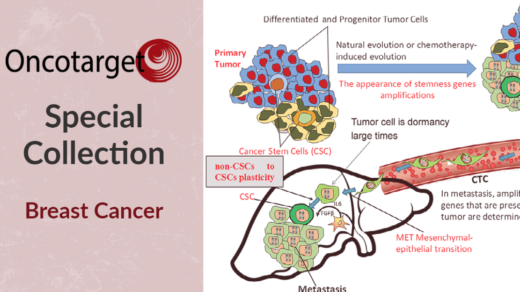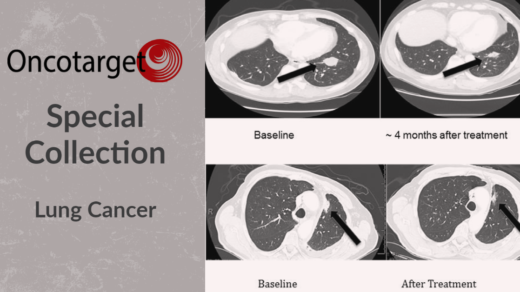In this new research perspective, researchers discuss the role of genetic alterations in resistance to BRAF inhibition and anaplastic transformation in thyroid cancer.
—
Thyroid cancer is a complex disease with various subtypes and clinical presentations. While some cases can be successfully treated with standard therapy, others present challenges due to resistance to treatment and the development of aggressive forms of the disease. In a new research perspective, researchers Mark Lee and Luc GT Morris from New York Presbyterian Hospital and Memorial Sloan Kettering Cancer Center discuss the recent research that has shed light on the role of genetic alterations in mediating both resistance to BRAF inhibition and anaplastic transformation in thyroid cancer. On January 24, 2024, their paper was published in Oncotarget, entitled, “Genetic alterations in thyroid cancer mediating both resistance to BRAF inhibition and anaplastic transformation.”
“An improved understanding of the molecular basis of thyroid cancer has led to the development of new targeted agents.”
Understanding Thyroid Cancer and its Molecular Landscape
Thyroid cancer is generally characterized by well-differentiated histology and a relatively indolent course. However, a subset of patients presents with more advanced disease or dedifferentiated histologies that are less responsive to standard therapy. These dedifferentiated subtypes include anaplastic thyroid cancers (ATC) and poorly differentiated thyroid cancers (PDTC), which are thought to arise from a process of microevolution from papillary thyroid cancers (PTC).
The mitogen-activated protein kinase (MAPK) pathway plays a crucial role in regulating cell proliferation and differentiation. Mutations in this pathway, particularly in the BRAF gene (specifically the V600E mutation), have been identified in a significant proportion of thyroid cancers. The BRAF V600E mutation leads to constitutive activation of the MAPK pathway, resulting in dedifferentiation and tumor progression.
BRAF Inhibition as a Therapeutic Approach
Given the role of the BRAF V600E mutation in thyroid cancer, targeted agents that inhibit BRAF have been explored as potential treatments. Sorafenib and lenvatinib were the first agents approved for use in thyroid cancer but have shown limited overall survival benefits. More recent agents, such as vemurafenib and dabrafenib, specifically target the V600E mutant oncoprotein and have demonstrated promising results in early trials.
However, despite initial responses, the long-term efficacy of BRAF inhibitors is limited due to the emergence of resistance mechanisms. Multiple compensatory pathways and mutations have been observed in thyroid carcinoma cells that mediate bypass of BRAF blockade, leading to disease progression. These mechanisms can be primary, already present in the tumor, or secondary, acquired over the course of treatment.
Genetic Alterations Associated with Resistance to BRAF Inhibition
Recent studies have identified specific genetic alterations that are associated with resistance to BRAF inhibitors and anaplastic transformation in thyroid cancer. One such alteration is the presence of mutations in the PI3K/AKT/mTOR pathway, particularly in the PIK3CA gene. These mutations paradoxically hyperactivate the ERK pathway when BRAF is inhibited, leading to decreased response to therapy].
Other genetic alterations associated with resistance include mutations in the MAPK/ERK pathway (such as MET amplifications, NF2, NRAS, and RASA1), the SWI/SNF chromatin remodeling complex (ARID2 and PBRM1), and the JAK/STAT pathway (JAK1). These alterations have been observed in tumors that dedifferentiate after treatment with BRAF inhibitors, suggesting their involvement in both resistance and anaplastic transformation.
Mechanisms of Anaplastic Transformation in Thyroid Cancer
Anaplastic transformation, the transition from well-differentiated to dedifferentiated thyroid cancer, is a rare but aggressive form of the disease. The mechanisms underlying anaplastic transformation are not fully understood but likely involve genetic and molecular changes that drive the loss of cellular differentiation.
Ultrastructural analyses have shown that well-differentiated thyroid carcinomas transforming into anaplastic thyroid cancers undergo changes in cellular architecture, including the loss of tight junctions, desmosomes, and cellular polarity. Molecular alterations associated with anaplastic transformation include aneuploidy, increased copy number alterations, and mutations affecting genes such as p53, bcl-2, cyclin D1, β-catenin, Met, c-myc, Nm23, and Ras.
Overlapping Mechanisms of Resistance and Anaplastic Transformation
Recent research has revealed a significant overlap between the genetic alterations associated with resistance to BRAF inhibitors and the development of anaplastic thyroid cancer. Studies have shown that tumors that dedifferentiate after BRAF inhibition are enriched in known genetic alterations that mediate resistance to BRAF blockade, including mutations in the PI3K/AKT/mTOR, MAPK/ERK, SWI/SNF chromatin remodeling complex, and JAK/STAT pathways.
These findings suggest that selective pressures exerted by BRAF inhibition can promote the outgrowth of subclones harboring these mutations, ultimately leading to anaplastic transformation. The complex and multifactorial nature of these compensatory mechanisms underscores the need for alternative treatment strategies to address resistance and improve long-term disease control.
Immune Microenvironment in Resistance and Anaplastic Transformation
The immune microenvironment of thyroid tumors has been a topic of active investigation, as it plays a crucial role in both tumor pathogenesis and drug resistance. While BRAF inhibitors are thought to increase anti-tumor immunity, they may also have competing effects, such as driving tumor infiltration by macrophages. Anaplastic thyroid cancer is associated with changes in the immune milieu, including increased infiltration by macrophages and fibroblasts.
The immunosuppressive microenvironment observed in resistance to BRAF inhibitors and anaplastic evolution suggests a potential role for combined targeted therapy with immunotherapy. Preclinical studies have shown that the combination of BRAF inhibitors with immune checkpoint inhibitors can enhance anti-tumor immune activity. Clinical trials evaluating the efficacy of combined BRAF blockade with immunomodulatory therapies are ongoing, with preliminary results showing promising anti-tumor effects.
Current Approaches and Future Directions
The current standard therapeutic approach for locally advanced, recurrent, metastatic, and dedifferentiated thyroid cancers involves surgical resection and adjuvant radioactive iodine therapy. However, in cases where surgery is not feasible or tumors are resistant to standard therapy, targeted agents have emerged as potential treatment options.
For patients with ATCs harboring the BRAF V600E mutation, neoadjuvant combination kinase inhibition with dabrafenib plus trametinib has shown promise . Other targeted agents, such as everolimus (MTOR inhibitor), crizotinib (MET inhibitor), and PI3K inhibitors, have demonstrated antitumor activity in preclinical and early clinical studies.
Combined BRAF blockade with immunotherapy is also being investigated as a potential treatment strategy. Early clinical trials have shown promising outcomes, with significant partial response rates and stable disease rates in advanced thyroid cancers. However, further studies with long-term follow-up are needed to evaluate the real-world effectiveness of these novel immunotherapies in combination with targeted therapy.
Conclusion
Genetic alterations play a crucial role in mediating both resistance to BRAF inhibition and anaplastic transformation in thyroid cancer. Understanding the mechanisms underlying these processes is essential for developing effective treatment strategies. Targeted therapies, such as BRAF inhibitors, have shown initial promise but are limited by the emergence of compensatory mechanisms.
The identification of specific genetic alterations associated with resistance and anaplastic transformation provides insights into potential therapeutic targets. Combined targeted therapy with immunomodulatory agents is being explored as a means to enhance anti-tumor immune activity and overcome resistance. Ongoing clinical trials will further elucidate the effectiveness of these novel treatment approaches and pave the way for personalized therapies for patients with thyroid cancer.
In conclusion, the study of genetic alterations in thyroid cancer has provided valuable insights into the development of resistance to targeted therapies and the progression to more aggressive forms of the disease. By understanding the underlying mechanisms and identifying potential therapeutic targets, researchers can work towards improved treatment strategies and better outcomes for patients with thyroid cancer.
“Dual-target therapies have been trialed but with continued limitations to long-term disease control. Thyroid tumor dedifferentiation and BRAF inhibitor resistance are also found to be associated with a transition to an immunosuppressed state. Early studies on combined targeted and immune-modulated therapy have demonstrated promising outcomes. Further clinical studies are needed to test real-world effectiveness of these novel immunotherapies with targeted therapy.”
Click here to read the full research perspective in Oncotarget.
—
Oncotarget is an open-access, peer-reviewed journal that has published primarily oncology-focused research papers since 2010. These papers are available to readers (at no cost and free of subscription barriers) in a continuous publishing format at Oncotarget.com. Oncotarget is indexed/archived on MEDLINE / PMC / PubMed.
Click here to subscribe to Oncotarget publication updates.
For media inquiries, please contact media@impactjournals.com.



